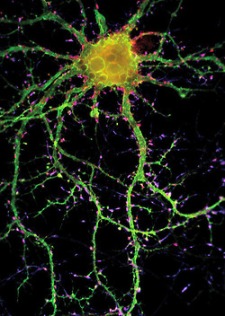Earlier this week my child & adolescent therapy class discussed an unfortunate situation involving multiple children being take in by relatives after their mother was arrested. The question was how best to help children in a situation like that, and help them cope with a suddenly chaotic existence infused with grief, loss, anger, and fear. At one point I wondered aloud where the father of the children was in all of this, and a person who was familiar with the family said, “It’s not relevant to this situation.” If that’s true, then I feel even worse for these children.
If you’d like more information, the U.S. Department of Health and Human Services has put together an extensive resource list called Resource Listings of Selected National Organizations Concerned with Fatherhood and Child Maltreatment. There are programs to get fathers involved in schools, information for stay-at-home dads, resources for low income fathers, minority fathers, incarcerated fathers, parenting groups, and more.
And last but not least, a list.
1. Lets your child know that you love her. Love involves more than saying the words, “I love you.” Fathers who love their children demonstrate their love by spending quality and quantity time together. Children who feel loved are more likely to develop a strong emotional bond with their father and a healthy self-esteem.
2. Provides your child with greater financial resources. Research clearly indicates that families with an active father are “better off” financially. This means that children with active fathers will be more likely to have access to resources that facilitate healthy development (e.g., food, clothing, shelter, quality medical care).
3. Provides your child with a positive male role model. Children, regardless of gender, need positive male and female role models. Children tend to model behavior (positive and negative) that they witness on a consistent basis. Active fathers can promote positive behaviors by setting a proper example for their children.
4. Provides your child with emotional support. In addition to financial support, children also need emotional support from their parents. Active fathers listen and support their children when they experience joy, sadness, anger, fear, and frustration. Fathers who support their children emotionally tend to raise children who are more in-tune with the needs of others.
5. Enhances your child’s self-esteem. Self-esteem refers to how a person feels about himself. Children with high self-esteem tend to be happier and more confident than children with low self esteem. Active fathers promote their children’s self-esteem by being fully involved in their lives and letting them know that they are highly valued.
6. Enhances your child’s intellectual development. Children who are raised with actively involved fathers tend to score higher on measures of verbal and mathematical ability, and also demonstrate greater problem-solving and social skills.
7. Provides your child with guidance and discipline. From infancy, children need proper guidance and discipline. Active fathers play an important role in teaching their children proper behavior by setting and enforcing healthy limits.
8. Gives your child someone to play with. One of the primary ways that fathers bond with their children is through play. According to researchers, there are qualitative differences in the ways fathers and mothers play with their children. Fathers tend to use a more physical style of play (e.g., wrestling) that offers a number of benefits to children, including enhanced cognitive ability.
9. Provides your child with someone to talk to when she has questions. Young children are full of questions. This natural curiosity helps them learn about their environment. Active fathers can be a valuable source of information for children who are seeking answers to life’s important questions.
10. Increases your child’s chances for academic success. Children whose fathers are actively involved in their lives are more likely to achieve academic success than children whose fathers are not actively involved. These academic benefits appear to extend into adulthood.
11. Provides your child with an alternative perspective on life. Research indicates that men and women often differ in their parenting styles; however, one style is not necessarily better than the other. Instead, it can be healthy for children to be exposed to different perspectives on life, such as a father’s.
12. Lowers your child’s chances for early sexual activity. Children with actively involved fathers are less likely to engage in early sexual activity, thus reducing their chances for teen pregnancy and sexually transmitted diseases.
13. Lowers your child’s chances for school failure. Children with actively involved fathers are less likely to drop out of school than children with uninvolved fathers.
14. Lowers your child’s chances for youth suicide. Children with actively involved fathers are less likely to commit suicide than children with uninvolved fathers.
15. Lowers your child’s chances for juvenile delinquency. The benefits of having an active father throughout a child’s early years extend into the teen years as well. Children with active fathers are less likely to commit juvenile crimes than children with inactive fathers.
16. Lowers your child’s chances for adult criminality. The chances that a child will commit crimes as an adult also diminish when he grows up with an actively involved father.
17. Provides your child with a sense of physical and emotional security. One of the major benefits that fathers can provide to their children by being actively involved is a sense of security (physical and emotional). By being actively involved in a child’s life, a father promotes a trusting relationship. The child does not have to worry about being abandoned.
18. Facilitates your child’s moral development. Children need a moral compass to guide them when they face difficult moral choices. Fathers, like mothers, help children to develop a sense of right and wrong that serves as a foundation for establishing moral character.
19. Promotes a healthy gender identity in your child. Boys and girls benefit from having healthy role models from both sexes. Research points to the fact that mothers and fathers socialize their children in different ways. Fathers can help their children, especially boys, to develop a healthy sense of what it means to be a male.
20. Helps your child learn important life skills. Most of the essential life skills that children need to survive are learned within the home. Fathers have a unique opportunity to teach their children valuable skills that will enable them to grow up to be healthy and productive adults.

















 Prisons don’t use reading scores to predict future inmate populations
Prisons don’t use reading scores to predict future inmate populations